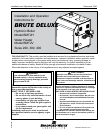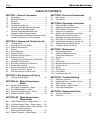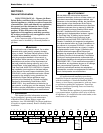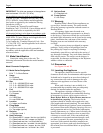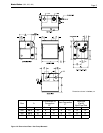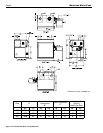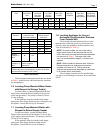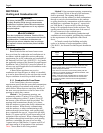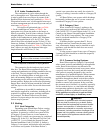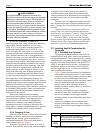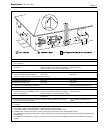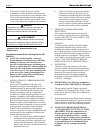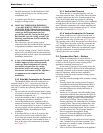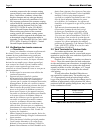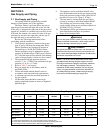
Brute Deluxe (200, 300, 400)
Page 9
2.1.2 Intake Combustion Air
The combustion air can be taken through the
wall, or through the roof. When taken from the wall,
it must be taken from out-of-doors by means of the
Bradford White horizontal wall terminal (see Table 1).
When taken from the roof, a eld-supplied rain cap or
an elbow arrangement must be used to prevent entry of
rain water (see Figure 2).
Use single-wall galvanized pipe, per Table
4, for the combustion air intake (see Table 1 for
appropriate size). Route the intake to the heater as
directly as possible. Seal all joints with tape. Provide
adequate hangers. The unit must not support the
weight of the combustion air intake pipe. Maximum
linear pipe length allowed is 50 feet (15.2m). Three
elbows have been calculated into the 50-foot (15.2m)
linear run. Subtract 10 allowable linear feet (3.0m) for
every additional elbow used (see Table 1). When fewer
than 3 elbows are used, the maximum linear pipe
length allowed is still 50 feet (15.2m).
Term Description
Pipe Single-wall galvanized steel pipe, 24 gauge
minimum (either insulated or non-insulated)
Joint Sealing Permanent duct tape or aluminum tape
Table 4. Required Combustion Air Piping Material.
The connection for the intake air pipe is on the
lter box. The Brute Deluxe appliances may have
venting and combustion air ducting attached to the top
or the back. They are shipped with the connections
at the top. For attaching either or both pipes to the
back, the mounting anges are reversible by removing
the mounting screws and orienting the anges in the
desired position. Replace the screws after positioning
anges. Run a bead of silicone around the collar and
slide the pipe over the collar. Secure with sheet metal
screws.
In addition to air needed for combustion, air
shall also be supplied for ventilation, including all air
required for comfort and proper working conditions
for personnel. The Brute Deluxe loses less than 1
percent of its input rating to the room, but other heat
sources may be present.
2.2 Venting
2.2.1 Vent Categories
Depending upon desired Brute Deluxe venting,
it may be considered a Category I or a Category III
appliance. In general, a vertical vent system will be
a Category I system. However, in rare instances, a
Brute Deluxe’s vertical vent system may be considered
Category III. In the U.S., the National Fuel Gas Code
(ANSI Z223.1), or in Canada the Natural Gas and
Propane Installation Code (CSA B149.1), denes a
Category I vent system, and includes rules and tables
to size these vent systems. If the Brute Deluxe’s
vertical vent system does not satisfy the criteria for
Category I venting, it must be vented as a Category III
system.
All Brute Deluxe vent systems which discharge
horizontally (without the use of a power venter) are
considered Category III vent systems.
2.2.2 Category I Vent
When vented as a Category I appliance, the
vent system must conform to the National Fuel Gas
Code (ANSI Z223.1-Latest Edition) in the U.S., or in
Canada, to the Natural Gas and Propane Installation
Code (CSA B149.1 latest edition). The vent system
must be sized and installed for a Category I Fan-
Assisted Appliance.
If chimney height is greater than 25 feet, or
if multiple units are vented into the same vertical
vent, a barometric damper must be installed on each
appliance, such that the ue draft does not exceed
(negative) 0.1 in. w.c.
If using a power venter for any type of Category
I venting, the draft should be set between (negative)
0.01 and 0.05 in. w.c.
2.2.3 Common Venting Systems
Brute Deluxe units are Category I fan-assisted
when vented vertically and adhering to all applicable
codes. Brute Deluxe units are not allowed to be
vented into a common horizontal vent system, unless
a properly sized vent fan is used, and the common
vent system is properly designed by the vent fan
manufacturer or a qualied engineer. When common
venting Brute Deluxe fan-assisted unit with other
appliances through one shared vertical duct called a
“common vent”, special care must be taken by the
installer to ensure safe operation. In the event that
the common vent is blocked, it is possible, especially
for fan-assisted devices, to vent backwards through
non-operating appliances sharing the vent, allowing
combustion products to inltrate occupied spaces.
If the appliances are allowed to operate in this
condition, serious injury or death may occur.
WARNING
Operation of appliances with a blocked common
vent may lead to serious injury or death. Safety
devices must be implemented to prevent blocked
common vent operation. If safe operation of all
appliances connected to a common vent cannot
be assured, including prevention of spillage of flue
gasses into living spaces, common venting should
not be applied, and appliances should each be
vented separately.



